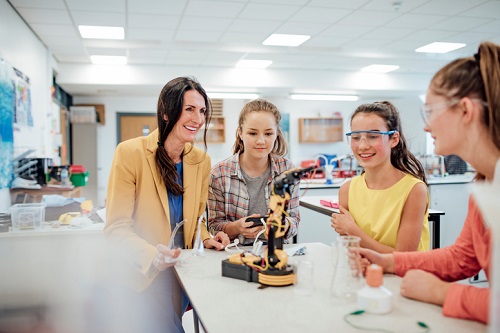
A new resource is encouraging female students to study and pursue careers in science, technology, engineering and maths (STEM).
The Girls in STEM Toolkit – announced by the Federal Government – will feature articles and case studies to motivate students on a new digital platform to be launched in 2019.
Minister for Industry, Science and Technology Karen Andrews said Education Services Australia will develop and deliver the toolkit, which was provided $580,000 funding in this year’s Budget.
Education Services Australia is a national not-for-profit company owned by the state, territory and Australian Government education ministers.
The toolkit will help school-age girls understand the diverse range of STEM careers available to them.
“Increasing female participation in STEM will make Australia’s research, scientific and business capability stronger,” Minister Andrews said.
“We need all our young people to understand the importance of STEM skills to jobs of the future and the Coalition’s toolkit will help young women further engage with STEM subjects.”
Minister Andrews said Australia’s future success depends on developing and encouraging the next generation of scientists, problem solvers and leaders “regardless of their gender, background or any other factor”.
“By providing our girls studying STEM with information and encouragement to stick with it, we will help them achieve their full potential as scientists, innovators or entrepreneurs,” she said.
The initiative addresses the gender bias and stereotyping in science and maths, which begin in primary school and continue through high school to university and research.
One expert says the “real issue” is the need to focus on normalising girls in STEM “rather than sensationalising the lack of them”.
“If school leaders aim to increase female student engagement in STEM education, they need to shift the focus so that it becomes solution based,” Georgina Pazzi, founder and director of Edumazing, told The Educator.
“To do this they should emphasise the successes students have achieved in STEM ensuring girls are prominent in their stories, promote the importance of STEM with parents and work with female teachers to improve their own confidence and leadership in STEM so they become positive role models for girls.”
Pazzi added that all teachers must also be supported to recognise their own bias when it comes to gender within STEM and shifting these if needed.
“Another important focal shift is moving from STEM to STEAM by including the Arts as an important component of STEM learning,” she said.
“This provides greater opportunities to increase creativity and innovation, moving students from completing STEM experiments to becoming active STEAM learners where they are involved in creating real-world solutions.”


